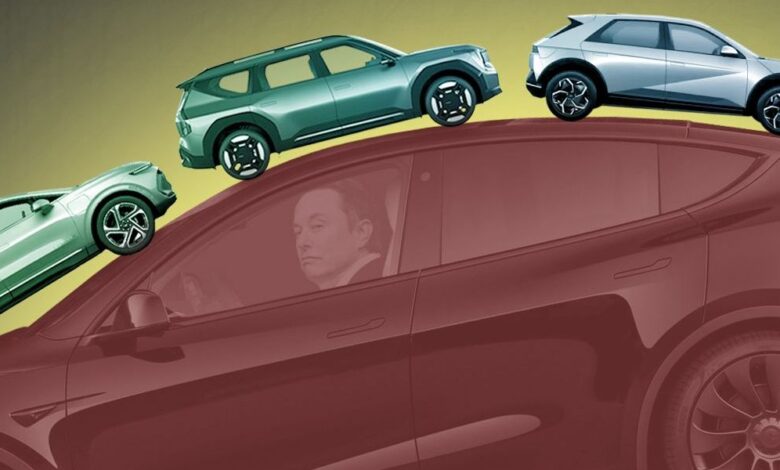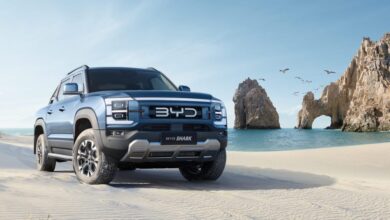May Was a Pretty Good Month for EVs

In the closing days of April, Elon Musk shocked the EV world when he laid off Tesla’s entire 500-person charging division.
The company suddenly — and seemingly for reasons of professional pique — gave up on its biggest competitive advantage. At a time when every other automaker was supposed to be moving to Tesla’s best-in-class charging network, Tesla seemed to be abandoning it.
The announcement shot the American EV industry through with fear and seemed to cement the broader industry’s malaise. If Tesla was giving up on EVs and becoming an “AI and robotics company,” what chance did anyone else stand?
More than a month has now passed. Tesla hasn’t released its sales figures yet for May, and it isn’t likely to do so until its shareholders vote on a $56 billion pay package for Elon Musk next week. Given how the company has been acting lately, its sales probably won’t inspire.
But in the meantime, we can take stock of the rest of the industry. And the results have been … pretty good! Hyundai, Kia, General Motors, and Ford all saw their best May ever for EV sales. With little fanfare, EVs continue growing as a share of American car sales and making concerted progress. Tesla’s future business might be a question mark, but EVs have a foothold in the rest of the industry.
Let’s break down the data:
Hyundai, one of the Korean automakers that has emerged as an electric power player in the U.S., says that its EV sales were up 42% nationwide year-over-year. The Ioniq 5, its all-electric hatchback, just had its best sales month ever. It has already sold nearly 21,000 cars in its Ioniq line-up so far this year.
Its Korean partner, Kia, also saw its electric sales double in May, which was Kia’s best month for EV sales ever. For the first time, Kia sold more than 7,000 all-electric cars in one month. Although it’s too early for this to appear in the sales data, Kia also began to produce its three-row SUV, the EV9, at its new assembly factory in Georgia this month, which means that the EV9 will qualify for the full $7,500 tax credit under the Inflation Reduction Act.
So far this year, Kia has sold more than 16,000 EV6 and EV9s. (Hyundai and Kia also sell plug-in hybrids, but they don’t regularly break them out in their monthly sales data announcements.)
American automakers also put up solid numbers. General Motors recorded its best-ever month for EV sales in May — even though it has now stopped selling the Chevrolet Bolt, which was previously the cheapest EV on sale in America. But GM’s new electric platform, Ultium, is starting to fill the gap. Sales of the Cadillac Lyriq, which had previously lagged GM’s cars, are suddenly surging; the vehicle is on track to outsell the Tesla Model X this year. This month, Chevrolet launched the Chevrolet Equinox EV, a two-row SUV starting just around $43,000 that got “surprisingly great” reviews. The Equinox qualifies for the full EV tax credit.
Ford also put up decent numbers: May was its third-best month for EV sales ever. Sales of the Ford Lightning, Mustang Mach E, and E-Transit van were all up by 46% year-over-year, and Ford’s electric sales overall are 88% above where they stood at the same time last year. But Ford, unlike GM, hasn’t announced any new electric cars in the pipeline.
Other good news came not in the form of sales, but in product announcements and updates. The automaker Stellantis — you might know it best as Fiat-Chrysler — disclosed that it will release a $25,000 all-electric Jeep in America soon, based on the same platform as the cheap EVs that it already sells in Europe.
The electric automaker Rivian also made progress on its goal to become profitable by the end of the year. The EV truckmaker has reopened its factory in Normal, Illinois, after retooling and renovating it last month. It also unveiled new versions of its flagship R1S SUV and R1T pickup with more range and new features. While Rivian’s ultimate survival will be determined by its sales in the second half of the year, it is checking the boxes on its plan to stop burning cash by 2025.
“The last two weeks have had good vibes for maybe the first time all year,” Corey Cantor, an analyst at Bloomberg NEF, told me. “A lot of the companies that have had to make progress are starting to make progress.”
The one big weak spot in the month was in charging. As predicted, Musk has hired back some of the charging employees that it laid off five weeks ago, but the rate of its charging expansion has slowed — and no other company has stepped up to fill the gap. GM has said that its EV drivers will have access to Tesla’s network by “spring 2024,” a deadline that will arrive in 13 days. And the charging network funded by the Bipartisan Infrastructure Law has yet to produce more than a handful of stations.
Another point of caution: It’s still unclear whether EV sales in May will fall overall — but that would be entirely because Tesla, which makes up a large share of EV sales nationwide, has seen such slowing deliveries lately. In recent months, EV sales have had a “Tesla problem,” where every automaker that isn’t Tesla sees record growth, but Tesla brings down the overall rate. There’s a positive way to view that trend (the EV transition is broadening beyond Tesla!) and a negative way (fewer folks are buying EVs overall). That could happen again this month: We won’t know until Tesla reports its monthly figures.
Still, even in a year defined so far by big road bumps for electric cars, the direction of travel is good.


![Ford teases new F-150 Lightning-based EV SuperTruck [Video] Ford teases new F-150 Lightning-based EV SuperTruck [Video]](https://europeantech.news/wp-content/uploads/2024/05/1716924654_Ford-Pikes-Peak-F-150-Lightning-390x220.jpg)
